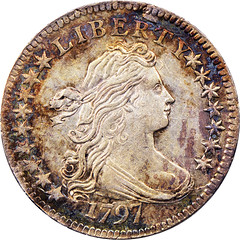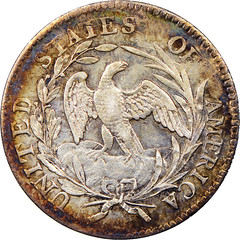
PREV ARTICLE
NEXT ARTICLE
FULL ISSUE
PREV FULL ISSUE
SEEING STARS ON UNITED STATES COINAGEDave Lange writes: "The 1891 letter from Director Leech to Superintendent Bosbyshell regarding five-pointed versus six-pointed stars reminded me of a two-part column I wrote years ago for The Numismatist. It took me awhile to find it at the NGC website, because the installments were published nonconsecutively."
Thanks! Here's an excerpt - see the complete articles online. I added a coin image from NGC Coin Explorer. -Editor


Count the stars... Among the most common design elements on United States coins are stars. Many of the older USA coin types featured 13 stars, representative of the original states that declared their independence from Britain in 1776. Of our current coin types, only the Kennedy half dollar still bears these 13 stars. They appear above the eagle in addition to a circle of 50 stars, both features being components of the presidential seal depicted on the half dollar's reverse. If one considers the Anthony dollar to be a current type (I still get them in change from the post office once in awhile), then it too bears an arc of 13 stars on its obverse. The Roosevelt dime has no stars, while the Jefferson nickel has but one, which is used as a "stop" for the legends. The Lincoln cent likewise does not include stars in its design, though Frank Gasparro's original model for the Memorial reverse of 1959 bore 13 stars (these were removed at the direction of the Treasury secretary to achieve a less cluttered look). The current state quarter series include among its entries many designs having various numbers of stars, these having either national or local significance. The first coins issued by the USA were the Fugio cents. Dated 1787, numerous varieties were produced, yet the only star that appeared on most of these was our sun, shown in the ancient fashion as having a face. A single variety of the Fugio series features eight-pointed stars on a garter, but these were used solely as stops between the words STATES and UNITED. Among the 1792-dated pattern coins of the infant U.S. Mint, only the half dimes bore a star—a single, five-pointed star which, in the traditional language of heraldry, is known as a mullet. Strictly speaking, in heraldry only the six-pointed depiction may be called a star, yet both variants have been used interchangeably on United States coinage. In American numismatics the mullet is sometimes referred to as an American star, while the six-pointed version is described as an English star, but I've not been able to find any definitive source for such usage. The so-called English star predominates on 18th and 19th Century United States coins, but it gave way to the American star for most 20th Century issues. Charles Barber's quarter dollar and half dollar of 1892 appear to have been transitional, as they feature six-pointed stars on the obverse and five-pointed ones on the reverse. Barber himself was English-born, but it's doubtful that this played any role in his decision. Fellow U.S. Mint Engraver George Morgan was likewise an Englishman, yet he utilized six-pointed stars for both sides of his 1878 silver dollar. The first mass-produced coins of the U.S. Mint to display stars as a regular feature of their designs were the silver dollars, half dollars and half dimes of 1794. These bore 15 stars around the bust of Liberty, representing the number of states in the Union at that time. This number was carried over from the first cents of 1793, which featured 15 interlocking chain links. As Tennessee was admitted to the Union in 1796, newly prepared dies for the silver and gold coins included 16 stars. This resulted in a somewhat crowded appearance, and it was decided a short time later that only the original 13 states could be honored in this fashion. An example of how rapidly this transition occurred may be seen in the half dimes dated 1797. These come with alternately 15, 16 or 13 stars, the dies having been prepared in that order.
To read the complete articles, see:
To read about the 16-star 1797 dime, see:
To read the earlier E-Sylum article, see:

Wayne Homren, Editor The Numismatic Bibliomania Society is a non-profit organization promoting numismatic literature. See our web site at coinbooks.org. To submit items for publication in The E-Sylum, write to the Editor at this address: whomren@gmail.com To subscribe go to: https://my.binhost.com/lists/listinfo/esylum All Rights Reserved. NBS Home Page Contact the NBS webmaster 
|